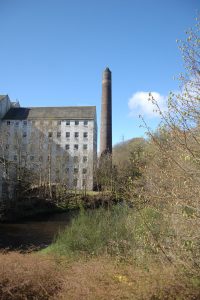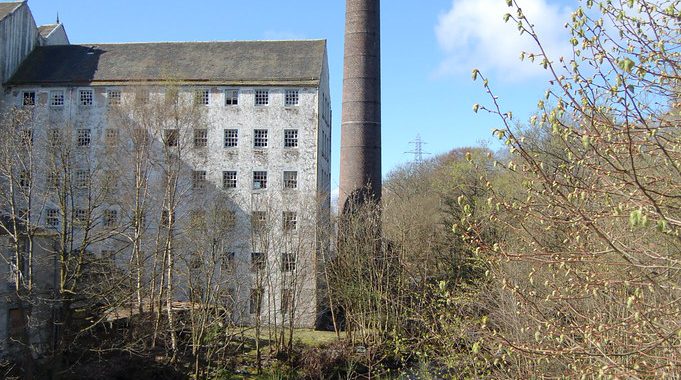On the Black Cart, just below Milliken and Cochrane Mills is a low dam. From this dam a wide lade continues, under a purpose built arch in the bridge over the Cart, to Cartside Cotton Mill (now a paper mill). The mill was built in 1792 by the owners of Calderpark Cotton Mill at Lochwinnoch. Cartside was one of six Johnstone mills built between 1782 and 1796. Their owners are well known, and our interest here is in how the mills were powered.
From Cartside Mill, the lade continues downstream for more than 2.5km, partly in a brick-arched tunnel, to drive three other big cotton mills: Hag (1794), Johnstone Old (1782) and Johnstone Laigh (1783). Two small mills, Milliken waulk mill and a lint mill were both still operating in the 1790s. They stood on the opposite side of the river from Hag Mill, which was demolished in the 1920s.
Further downstream, Johnstone Old Cotton Mill was built beside the old Johnstone grain mill, at Johnstone Bridge. The Old Cotton Mill was the oldest surviving cotton mill in Scotland, until it was destroyed by fire in 2010.

Old Cotton Mill Johnstone
From the Johnstone Old Cotton Mill the lade continued through a special arch under Johnstone Bridge, then through the town’s old bleaching green to Johnstone’s fourth big cotton mill, the Laigh Cotton Mill. Below Laigh Mill the tailrace continued downstream for 500 metres to a point not far above the dam for Linwood Cotton Mills.
Slightly further downstream, the Peockland Burn enters the Black Cart below Linwood Dam. This burn is the confluence of the Craigbog and Floors burns. Despite its modest size, at one time the burn powered a number of mills, and also drained the Quarrelton Coal Mines via a water powered engine. Two smaller water powered cotton mills, Bank Top (1792) and Montgomeries Mill (1796), were built on the burn. However, when a planned expansion of their reservoirs threatened to flood the town, these mills were soon converted to steam power.
Johnstone had numerous other textile factories, though none were water powered. However, according to the late Sylvia Clark, Johnstone had a seventh water powered cotton mill, the Adelphi Mill in Graham Street, fed from the Peockland Burn. When the Catholic Church was being built, an underground lade and a wheel pit were discovered on the site.
© 2016, Stuart Nisbet, Renfrewshire Local History Forum

